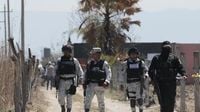On the morning of October 20, 2025, the tranquil streets of La Estancia, a small community in central Mexico’s Hidalgo state, were shattered by the sound of gunfire. Miguel Bahena, the mayor of Pisaflores, was intercepted in broad daylight by armed men who opened fire before fleeing the scene, according to police reports cited by Caliber.Az and AFP. The attack left Bahena’s body lying in the street with at least five bullet wounds, a stark and chilling reminder of the dangers faced by public officials in Mexico.
The brazen assassination of Mayor Bahena is not an isolated incident but rather the latest in a string of violent attacks targeting local politicians across the country. The Green Party, to which Bahena belonged, wasted no time in condemning the act. In a statement released shortly after the news broke, the party expressed its “profound dismay” and called the killing a “cowardly murder.” The Green Party demanded swift justice, urging authorities to “clarify the facts and arrest those responsible.”
Barely two weeks before the attack, Pisaflores itself had been in the headlines for a very different reason: devastating heavy rains that swept through central and eastern Mexico. The storms left 76 people dead and 27 missing, according to federal Civil Protection reports. The town was still reeling from the aftermath, grappling with the dual crises of natural disaster and political violence.
Bahena’s murder is part of a deeply troubling trend that has plagued Mexico for nearly two decades. Drug-related violence and the presence of powerful criminal organizations have made the country one of the most dangerous places in the world for public officials. According to data compiled by AP News and Animal Político, more than 35 local politicians and candidates have been assassinated in Mexico so far in 2025 alone. The Secretariat of Security and Citizen Protection (SSPC) has noted that this political violence is especially concentrated in rural municipalities, where criminal groups vie for control over local budgets, drug trafficking routes, and decision-making power.
Just a few months prior, in June 2025, gunmen stormed a mayor’s office in southern Mexico, killing the mayor and a staff member in a shocking attack that underscored the vulnerability of local officials. The violence didn’t stop there; the very next day, another mayor in western Mexico was murdered along with her husband. And back in May, two senior aides to Mexico City’s mayor were gunned down in broad daylight in the capital, with at least 13 suspects arrested in connection with the case. In April, a candidate for municipal president in Veracruz was executed as his campaign was just getting underway.
The violence is not limited to one region. In the state of Michoacán, for example, six mayors have been murdered since the start of the current federal administration, according to figures reported by the Mexican Press Agency. Other states such as Guanajuato, Guerrero, Sinaloa, and Zacatecas continue to be plagued by high levels of violence, with organized crime maintaining a strong presence and ongoing clashes between armed groups fueling further bloodshed.
Despite these grim headlines, there are some signs of hope—at least in the broader context of national homicide rates. Official data indicates that between September 2024 and July 2025, the average daily homicide rate in Mexico dropped from 86.9 to 64.9 victims, representing a 25% reduction. In September 2025, the country reached its lowest homicide level in a decade, with an average of 59.5 murders per day. That figure marks a 32% decrease compared to September 2024. Still, the overall numbers remain staggering: Mexico closed 2024 with 30,057 intentional homicides, a slight 1.2% increase over the previous year but signaling a stabilization after a decade of historically high figures.
Yet, as the statistics show improvement, the reality on the ground for many local leaders remains perilous. The persistent targeting of mayors and political candidates highlights the ongoing battle for control in regions where the state’s presence is weak and criminal organizations wield significant influence. The SSPC has repeatedly warned that rural municipalities are especially vulnerable, as criminal groups seek to infiltrate local governments, siphon off public funds, and secure strategic positions along drug trafficking corridors.
For the residents of Pisaflores and the wider Hidalgo region, the assassination of Mayor Bahena is a devastating blow. The town, already struggling with the aftermath of deadly floods, must now cope with the loss of its elected leader. The Green Party’s statement captured the somber mood: “The Green Party expresses its deepest consternation at this cowardly murder and demands the clarification of the facts and the arrest of those responsible.”
Local and national authorities have pledged to investigate the attack and bring those responsible to justice. But for many in Mexico, such promises ring hollow, given the long history of impunity that has fueled cycles of violence. According to Caliber.Az, previous high-profile assassinations have seen mixed results, with some suspects apprehended but many cases still unresolved.
The wave of violence against public officials has sparked debate across the political spectrum. Some argue that the federal government must do more to protect local leaders, particularly in rural and high-risk areas. Others point to the need for deeper reforms to address corruption, strengthen law enforcement, and tackle the root causes of organized crime. There are also voices calling for greater community involvement and transparency in local governance, hoping that increased civic engagement can help deter criminal infiltration and restore trust in public institutions.
The broader context is sobering. While the national homicide rate has seen a notable decline, the concentration of violence in certain regions and among specific targets—like mayors and political candidates—suggests that the underlying issues remain far from resolved. The stabilization of murder rates, as reported by the Mexican Press Agency, may offer some comfort, but the continued spate of assassinations sends a clear message: for many on the front lines of Mexican politics, the risks are as high as ever.
As Pisaflores mourns the loss of its mayor, the community’s resilience will be tested once again. The call for justice echoes not just in Hidalgo but across a nation weary of violence and eager for change. Whether the murder of Miguel Bahena will serve as a catalyst for meaningful action remains to be seen, but for now, his death stands as a stark reminder of the challenges facing Mexico’s democracy and the enduring courage of those who serve it.




